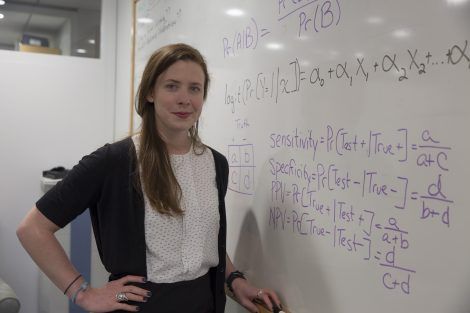Kathryn Rough, SD ’17, uses deep quantitative analysis skills to examine drug-related health issues
April 14, 2017 – Kathryn Rough is a self-professed data junkie.
As a doctoral student in epidemiology at Harvard T.H. Chan School of Public Health, she has spent scores of hours analyzing large datasets to shed light on drug use and drug safety. She has examined methods for detecting aberrant use of prescription opioids by using health insurance claims data, and has evaluated the comparative safety of antiretroviral regimens used to treat HIV-infected women by using data from long-term studies about their children’s health.
Rough earned a master’s in epidemiology from Harvard Chan School in 2014 and finished work on her doctorate this March. She got hooked on epidemiology, which focuses on finding patterns and causes for health issues in population groups, because she loves problem-solving and she wants to help improve people’s health—and epidemiology involves both.
Drug questions
After graduating from Boston University in 2011 with a degree in health sciences with a public health minor, Rough wanted to gain experience doing health-related research. She spent a year and a half as a research assistant for the healthcare firm Inflexxion, working with epidemiologists studying opioid misuse and abuse. Her role was quality control; she checked analyses and reporting done by the epidemiologists at every stage of the research.
“It was great exposure to what a career in epidemiology would be like, and really inspired me to go back to school to get the proper training so that I could do epidemiological analyses myself,” Rough said.
As a student at Harvard Chan School, Rough continued to study opioid use and abuse, working part-time for a research group at the Division of Pharmacoepidemiology & Pharmacoeconomics of Brigham and Women’s Hospital and Harvard Medical School (“DoPE” for short). The group was using health insurance claims data from millions of people across the U.S. to analyze the use of prescription opioids. Such data are “a treasure trove if you want to be doing big data analytics,” Rough said.
At DoPE, Rough tested the effectiveness of algorithms that are used to identify people who might be misusing or abusing opioids, or selling them on the black market. The algorithms are used by government agencies, insurers, and academics, though no one had looked at how well they work.
“We tested them all in the insurance claims dataset to see how someone being flagged for misuse or abuse correlated with later getting a diagnosis that indicated they had a drug problem, such as an overdose,” Rough said. “And we found that while the algorithms picked up on the highest risk group, they missed a lot of other people who had problems. A lot of the algorithms were based on expert opinion, not on empirical data. We wanted to create a much more data-driven approach.”
An abstract Rough wrote about the need to improve one of the algorithms won a prize at an international pharmacoepidemiology conference in 2015.
Paying it forward
Rough chose Harvard Chan School partly because of its strong emphasis on mentorship, and she credits her co-advisors—George Seage and Sonia Hernández-Díaz, both professors of epidemiology—with providing invaluable support and encouragement. A top-performing student, Rough became a mentor herself—she was selected as a teaching assistant for multiple courses.
Rough was also invited to help develop a new course on study design for Harvard Chan’s part-online, part on-campus MPH in Epidemiology program. She served as a teaching assistant for the course; developed the materials for one of the lectures in the course, on prediction modeling; and taught the online lecture on prediction modeling. Filming the lecture was “a little bit of a process” for Rough, who said her usual teaching style involves asking a lot of semi-rhetorical questions. “That doesn’t translate well when no one’s there to answer you,” she laughed. “But it was a really great experience.”
In addition, she has volunteered for the Samaritans, a suicide prevention organization, over the past year. She lost a friend to suicide seven years ago, so the organization’s mission appealed to her. The volunteer work has also helped her engage with the Boston community.
“In my research, I’ve tended to gravitate toward working with populations that are slightly stigmatized and underserved,” she said. “But I have no interaction with the people I may be helping—I’m at a computer all day.” Talking with people struggling with depression, drug use, or violence has sometimes been mentally and emotionally draining, she said—but also deeply rewarding.
Machine dreams
Rough is interested in machine learning—the ability of computers to “learn” when exposed to new data, without being explicitly programmed—and how it might contribute to health. She was intrigued when she read a December 2016 JAMA study in which Google researchers developed a “deep learning” algorithm that enabled a computer to diagnose diabetic retinopathy—a diabetes-related eye disease that can harm vision—as well as or better than an ophthalmologist. The algorithm was based on thousands of photos of retinas and doctors’ diagnoses made from those images.
Impressed with Google’s efforts, Rough applied and was accepted to the company’s Brain Residency Program—a 12-month program aimed at jumpstarting careers in deep learning research. Starting in July, she’ll spend a year at Google headquarters in Mountain View, Calif., working alongside deep learning research scientists and engineers on the Google Brain team.
The type of deep learning technology described in Google’s study about diabetic retinopathy diagnosis could play an important role in parts of the world where medical specialists are in short supply, Rough said.
“In some parts of the world, you could have a single ophthalmologist serving maybe 100,000 people,” she said. “Obviously one provider can’t care for that many people. My hope is that I could steer these new technologies toward improving health care in places where it’s needed most.”
photo: Sarah Sholes
